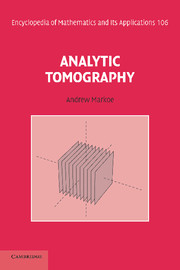Book contents
5 - Generalizations and Variants of the Radon Transform
Published online by Cambridge University Press: 24 October 2009
Summary
Introduction
There are two main ways of generalizing the Radon transform. One can add a weight to the hyperplane integral or one can integrate over subvarieties that are not linear. The first idea leads to the generalized Radon transform in ℝn that we study in section 5.4. An example of a generalized Radon transform is the attenuated Radon transform. This transform is of practical importance because it models single-photon emission computed tomography (SPECT). We investigate the attenuated Radon transform in section 5.3 along with the exponential Radon transform that is also used in SPECT. In this section we also mention positron emission tomography (PET), although this version of tomography reduces to the standard Radon transform.
Another way of generalizing the Radon transform is to integrate over more general submanifolds of ℝn than hyperplanes and k planes. More generally, we can integrate over submanifolds of a manifold X that is more general than ℝn. For example, Funk in his 1916 paper [184] showed that an even function on a sphere is completely determined by its integrals over great circles. This was a year before Radon's paper [508] appeared. The transform that sends a function on the unit sphere to its integrals over great circles is now called the Funk transform or the spherical Radon transform. A major advance in studying Radon transforms over nonlinear varieties was created in 1964 by Helgason [267] and we introduce this idea in section 5.5.
The divergent beam transform, a relative of the Radon transform is introduced and studied in section 5.2.
- Type
- Chapter
- Information
- Analytic Tomography , pp. 278 - 362Publisher: Cambridge University PressPrint publication year: 2006
- 1
- Cited by



